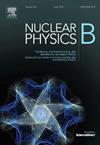高阶曲率重力下模糊暗物质不太复杂的虫洞结构
IF 2.8
3区 物理与天体物理
Q2 PHYSICS, PARTICLES & FIELDS
引用次数: 0
摘要
探讨了高阶曲率重力下具有各向异性物质分布的模糊暗物质虫洞解。导出了模糊虫洞的形状函数,并探讨了其可能的稳定性。我们采用一定的形状函数,研究了与模糊暗物质虫洞相关的活动引力质量的嵌入图。为了突出高阶曲率重力在不太复杂的模糊虫洞结构建模中的作用,我们评估了复杂性因子、守恒方程和零能条件。我们的研究强调了在不太复杂的区域内均匀分布的压力效应比模糊虫洞稳定性中能量密度均匀性的出现更为重要。结果表明,模糊虫洞结构的有效引力质量随径向距离呈反比变化,从而表明在Einasto指数的某些区域存在能量条件的突破。进一步揭示了在冷暗物质晕和星系凸起的环境下,自然界中存在稳定的模糊暗物质虫洞结构。从我们的分析中理解的重要物理学是,在高阶曲率引力中,模糊暗物质虫洞的可行几何形状自然存在于不同星系晕的环境中。本文章由计算机程序翻译,如有差异,请以英文原文为准。
Fuzzy dark matter less-complex wormhole structures in higher-order curvature gravity
Fuzzy dark matter wormhole solutions coupled with anisotropic matter distribution are explored in higher-order curvature gravity. We derive the shape function for fuzzy wormholes and explore their possible stability. We study the embedding diagrams of the active gravitational mass associated with fuzzy dark matter wormholes by taking a certain shape function. Aiming to highlight the role of higher-order curvature gravity in the modeling of less complex fuzzy wormhole structures, we evaluate the complexity factor, the conservation equation, and null energy conditions. Our study reinforces more importance of uniformly distributed pressure effects throughout the less complex region than the emergence of energy density homogeneity in the stability of fuzzy wormholes. It is shown that the active gravitational mass of the fuzzy wormhole structures varies inversely with the radial distance, thereby suggesting the breaching of energy conditions at some arena of the Einasto index. Furthermore, it is revealed that stable fuzzy dark matter wormhole structures exist in nature in the surroundings of cold dark matter halos and galactic bulges. The important physics understood from our analysis is that in higher-order curvature gravity, feasible geometries of fuzzy dark matter wormholes exist naturally in the environments of different galactic haloes.
求助全文
通过发布文献求助,成功后即可免费获取论文全文。
去求助
来源期刊

Nuclear Physics B
物理-物理:粒子与场物理
CiteScore
5.50
自引率
7.10%
发文量
302
审稿时长
1 months
期刊介绍:
Nuclear Physics B focuses on the domain of high energy physics, quantum field theory, statistical systems, and mathematical physics, and includes four main sections: high energy physics - phenomenology, high energy physics - theory, high energy physics - experiment, and quantum field theory, statistical systems, and mathematical physics. The emphasis is on original research papers (Frontiers Articles or Full Length Articles), but Review Articles are also welcome.
 求助内容:
求助内容: 应助结果提醒方式:
应助结果提醒方式:


